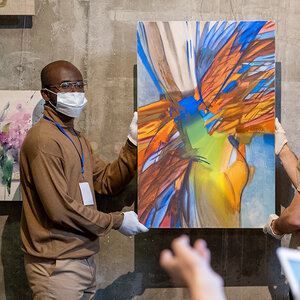Museums making modest gains in staff diversity, survey finds

The staffs of museums across the United States are increasingly becoming more diverse, though representation remains uneven, a report commissioned by the Andrew W. Mellon Foundation finds.
The report, Art Museum Staff Demographic Survey 2022 (46 pages, PDF), includes data collected between February and April 2022 from 328 museums providing information on more than 30,000 people and includes an assessment of the effect of the COVID-19 pandemic on museum staffing. Conducted by Ithaka S+R, in partnership with the Association of Art Museum Directors and the American Alliance of Museums, the report found that the most racially and ethnically diverse departments in museums—security, facilities, and education—saw the most substantial staff reductions in 2020. And while museums reported dramatically increased staffing in those areas in 2021 and 2022 as the pandemic abated, the report highlighted the continued vulnerability of people of color with respect to job stability.
Museum staff has grown modestly more diverse, as more than 40 percent of younger staff and newer hires are people of color, primarily Hispanic, Asian, and those who are of two or more races; however, fewer than 20 percent of staff overall were identified as people of color. While there has not been a significant increase in Black staff across all positions, between 2015 and 2022, the number of Black staff in museum leadership more than doubled, while tripling in information technology and quadrupling in curatorial positions.
Gender ratios have held consistent since 2015 (roughly 40 percent male, 60 percent female) but vary widely across all positions. Among intellectual leadership positions in museums, more than three-quarters are women. Overall, the representation of female employees in museum leadership has continued a steady and substantial increase from 58 percent in 2015, to 62 percent in 2018, to 66 percent in 2022. In line with findings from an October Council on Foundations report, the number of staff identifying as non-binary rose from 20 in 2018 to 160 in 2022—a small but significant measure of inclusion in terms of culture and representation.
The Mellon report cautions that while progress is being made, however unevenly, staff retention rates will be an important factor in maintaining current levels of diversity. As museums rebound from the pandemic, it remains to be seen if the field can build on recent gains and improve opportunities for professional growth, improve staff retention, and more fully embrace the growing commitment to equity, diversity, inclusion, and accessibility.
“Though progress remains slow and uneven, the demographics of museum employees across the country are becoming more reflective of the diverse communities their organizations serve,” said Mellon Foundation president Elizabeth Alexander. “We are pleased that the information and insights included in this latest survey will further equip and encourage American museums to build even more representative and robust arts and culture institutions throughout the United States.”
(Photo credit: Getty Images/shironosov)




